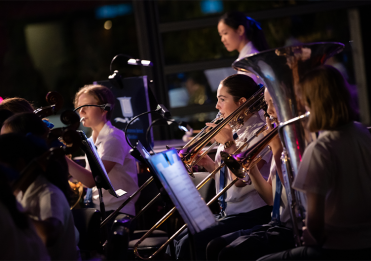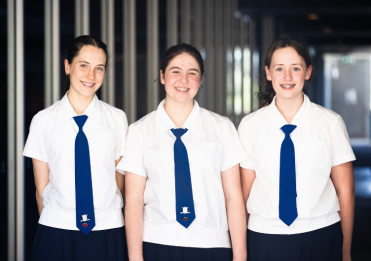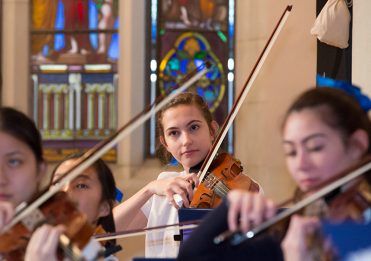Led by Head of Strings, Mr Michael Patterson, girls experimented with recording a simple arrangement of One Call Away by Charlie Puth, featuring Concert Master and Strings Captain, Hannah Kim (12M), as vocalist. While I am inspired by Hannah’s message of leadership to our Strings Program and find the three-minute performance utterly charming, I’m sure the performers would agree that this is most definitely a work in progress, and that there’s a lot to learn in unpacking the process behind our journey to create a truly wonderful virtual performance.
How does this all happen? What is the process behind creating a virtual music performance? And, what can we learn and refine from our first attempts? To answer this we need to consider some of the overarching requirements of a successful musical performance, starting with how to keep the beat.
How do musicians stay in time?
Firstly, a click track needs to be created, to which all musicians can listen so that they stay in time when recording themselves. This needs to be played through headphones so that the ‘click’ sound isn’t recorded along with the girl’s playing, corrupting the final result. Generally these click tracks have a bar of clicks to count students in, establishing the tempo, in the same way a conductor does when bringing an ensemble in with their baton. Mr Patterson’s creation for Chamber Strings went a step further, and rather than a simple click track, he provided girls with a drum kit to help them stay in time, and a backing track, to help them stay in tune.
How do musicians stay in tune?
As with any live rehearsal or performance, musicians need to tune their instruments, and this is achieved quite simply in a virtual world by directing students to tune to the standard A440. In the case of Chamber Strings, once that A strings is in tune, these more advanced musicians are able to adjust their remaining strings by ear, however there are many free apps to assist with tuning for musicians with less experience. If playing with a simple click track, girls then record their part while listening to the click, leading to presumably a perfect collection of parts ready to be layered into a sensational performance. Unfortunately, it’s not that simple.
One of the most powerful experiences of playing in any music ensemble is just that—the ensemble. What many don’t know is that in any given musical passage, individual performers will make hundreds of minute adjustments as they go, to synchronise and synergise with the larger ensemble. If we relate that to intonation, it’s all about what a musician hears around them in any given moment, and if that’s a simple click, there’s nothing there to respond to, which can result in a bland performance. By incorporating the backing track, Mr Patterson provided Chamber Strings with something to hold on to—a reference point, to enhance the finished product.
What about the sound?
When practicing together at school, students flood their respective rehearsal spaces with sound— spaces that have been acoustically designed to enhance music making. Observe any rehearsal, and you’ll witness a real energy in the room and feel the vibrations of music in the air. Chamber Strings especially have the ability to ‘play the room’, as well as their instruments, which demonstrates the beginning of more advanced stage of learning. Compare the glories of that live sound, with what you would hear through a small earpiece. There is simply no comparison.
What our first experiment has shown is that instead of ‘playing out’, with confidence and full sound, our musicians have responded conservatively, playing the correct notes at the right time, but not much more. To replicate the dynamics of a live performance, our musicians will need to step beyond the safety of their comfort zones and really give their all, trusting in each other to do the same, before we will begin to see anything that replicates the wonderful live work from this ensemble we all admire so greatly. This will lift performance, both musically, and visually, however there are still further refinements we can make.
What about the technicalities of recording?
Recording sound requires equipment, and what our students have to hand are their phones. Luckily, the technology is good and easy to use, however creating a quality recording is not as simple as placing a phone on a music stand and hitting the record button. Consider that as sound waves move through the air, metal music stands vibrate, which can create a tinny sound. To counteract this, students can experiment with microphone placement within their individual spaces, and in doing so, refine their aural perception and cognition.
Another complication is that individual microphone levels differ, which then requires careful balancing during post-production to achieve a good mix of sound. Some mixing programs don’t recognise newer file types, so many individual recordings need converting before they are able to be imported and then manipulated. Downloading programs to do that, takes time, and compiling all of this takes serious processing power.
To complicate the process, individual files don’t all start when the backing track does; there are differing lag times for each student, so every video needs to be cropped to the same starting point before they can be layered. Something we’ve learned is that we should get students to add a visual clap or other identifiable action at some point during the backing track count in, to ease this process.
No wonder this three-minute performance took Mr Patterson 15 hours to create!
What can we learn?
The process of creating a virtual music performance is incredibly rich in learning, and has the potential to allow focus on nuance within music making and performing we would otherwise overlook in the regular practice of day-to-day school life. Submitting audiovisual files gives students real opportunity to review and reflect on their own work, and then identify ways to enhance their own technical, performance and sound recording skills. Ensembles can work together on refining and curating their final product, which empowers the group to take perhaps a more overt realisation of ownership over a performance, than they may have had in the past. And of course, working harder to create that level of musicality and sensitivity within the music, despite all the barriers virtual performing brings, will make the experience of music-making all the sweeter when we do return to perform together in person.
Dean of Co-curriculum
Ms Ellena Papas




